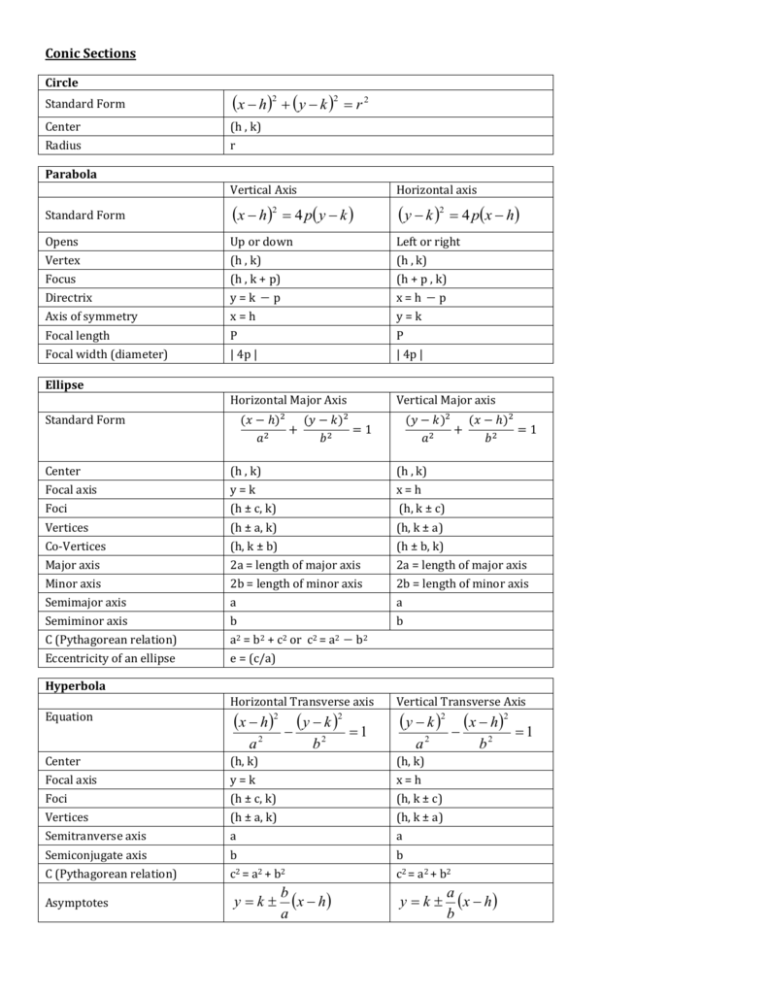Pre Calculus Conic sections formula sheet:
advertisement

Conic Sections Circle Standard Form x h2 y k 2 r 2 Center Radius (h , k) r Parabola Vertical Axis Horizontal axis Standard Form x h2 4 p y k y k 2 4 px h Opens Vertex Focus Directrix Axis of symmetry Up or down (h , k) (h , k + p) y=k p x=h Left or right (h , k) (h + p , k) x=h p y=k Focal length Focal width (diameter) P | 4p | P | 4p | Horizontal Major Axis Vertical Major axis Center Focal axis Foci (h , k) y=k (h ± c, k) (h , k) x=h (h, k ± c) Vertices Co-Vertices Major axis Minor axis Semimajor axis Semiminor axis (h ± a, k) (h, k ± b) 2a = length of major axis 2b = length of minor axis a b (h, k ± a) (h ± b, k) 2a = length of major axis 2b = length of minor axis a b C (Pythagorean relation) Eccentricity of an ellipse a2 = b2 + c2 or c2 = a2 e = (c/a) Ellipse Standard Form b2 Hyperbola Horizontal Transverse axis Equation x h 2 a2 y k 2 b2 1 Vertical Transverse Axis y k 2 x h2 a2 b2 Center Focal axis Foci Vertices Semitranverse axis (h, k) y=k (h ± c, k) (h ± a, k) a (h, k) x=h (h, k ± c) (h, k ± a) a Semiconjugate axis C (Pythagorean relation) b c2 = a2 + b2 b c2 = a2 + b2 Asymptotes yk b x h a yk a x h b 1 Classifying conic sections General form: Ax2+Cy2+Dx+Ey+F=0 Circles Parabola Ellipse Hyperbola A=C AC=0, Both are not 0 AC>0 AC<0 Discriminant test: The second degree equation: Ax2 + Bxy + Cy2 + Dx + Ey + F = 0 graphs as A hyperbola if B2 – 4AC > 0 A parabola if B2 – 4AC = 0 An ellipse if B2 – 4AC < 0 Translation-of-Axes Formulas: The coordinates (x, y) and (x’, y’) based on parallel sets of axes are related by either of the following translation formulas: x = x’ + h and y = y’ + k or x’ = x – h and y’ = y – k Rotation-of-Axes Formula: The coordinates (x, y) and (x’, y’) based on rotated sets of axes are related by either of the following rotation formulas: x’ = x cos + y sin and y’ = - x sin + y cos or x = x’ cos where , 0 < < , is the angle of rotation Coefficients for a conic in a rotated system: If we apply the rotation formulas to the general second-degree equation in x and y, we obtain a second-degree equation in x’ and y’ of the form2 A’x’2 + B’x’y’ + C’y’2 + D’x’ + E’y’ + F = 0 Where coefficients are A’ = A cos2 B’ = B cos 2 C’ = C cos2 D’ = D cos + E sin E’ = E cos F’ = F Angle of Rotation to Eliminate the Cross-Product Term If B ≠ 0, an angle of rotation such that cot 2 will eliminate the term B’x’y’ from the second-degree equation in the rotated x’y-coordinate system.








